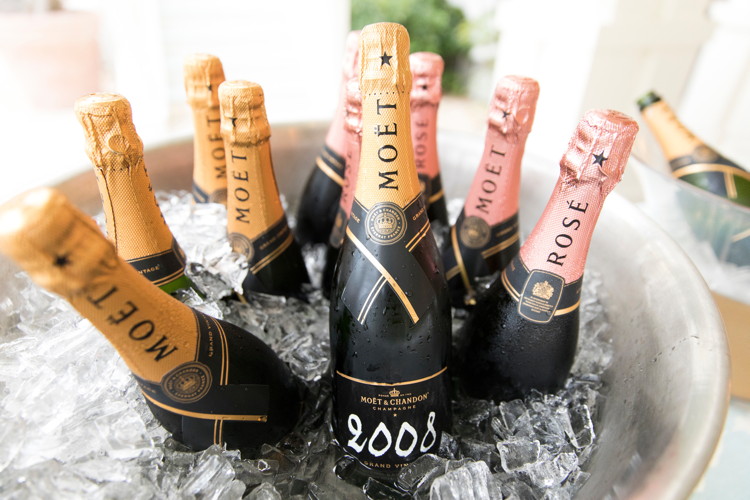One of the hottest regions in the wine and spirits world is Champagne, as the US comes to look at this luxury wine for drinking beyond the special occasion toast. You can enjoy Champagne with just about anything (the French have always known that), so to make the most out of your bubbly pairings we turned to Champagne and wine expert Seth Box, private client director for Moet Hennessy and a former winemaker in Italy, California, and New Zealand, for an expert’s guide. Here Box tells how you can do bubbly with everything from risotto to popcorn and apple pie!

Why the increased interest in pairing Champagne with various food courses?
It’s a natural progression as the U.S. evolves into a more established and sophisticated market for wine. It wasn’t that long ago restaurants in much of the country had “red”, “white”, and “blush” as their primary wine selections. That said, we’ve made progress. Real men drink rose’ now, and people continuously seek exposure to new food and wine experiences. This thirst for experience, particularly at the high end, has helped drive exploration of Champagne beyond the aperitif.
With wine, the tradition has long been red wine with red meats; whites with fish and poultry. What recommendations do you have for pairing Champagne with meat and fish?
The adage of white with fish and poultry and red with meat is a bit dusty. A friend of mine is the winemaker of Ruinart Champagne. He once recommended filet mignon with mature, vintage Champagne. I tried it with 1990 Dom Ruinart and it was incredible. To keep it simple, Champagne loves salt and fat. I’m of the mind that fried chicken and Champagne is a classic pairing, and wouldn’t miss a chance to have truffle fries or popcorn with good bubbles. Veuve Clicquot Yellow Label or Moet Imperial with salmon, tuna and oysters of virtually any preparation is delicious. Another memorable pairing was Moet Grand Vintage Rose’ 2008 and lamb. For poultry and red meat, I lean towards rose’ [Champagne] because the addition of red wine (which is what makes it pink) adds structure that holds up to heartier cuisine.
What recommendations would you make for Champagne with pasta or risotto?
Linguine and clams with a white wine sauce and Blanc de Blanc (100% Chardonnay) is hard to beat. Ruinart makes one which is creamy and crisp, a perfect pairing. Spaghetti Carbonara with Krug Grande Cuvee is one of the more decadent combinations I’ve enjoyed. Savory, salty, and powerful. A well-made mushroom risotto with Dom Perignon has been a go-to date night meal in my house for years. The acid cuts through the richness and fat, while the bubbles cleanse the palate between bites.

What are your recommendations for Champagne with dishes that are primarily salads, or vegetable based?
Keep it simple and fresh. Young, vibrant, non-vintage Champagne with most salads is a home run. Champagne is fantastic way to elevate one’s greens, whether they are dressed with a light vinaigrette to creamy ranch,.
Suggestions for Champagne and fast food/sandwiches?
In keeping with the guidelines that Champagne loves salty, fatty foods, I put on a dinner series called “burgers & bubbles” which has been wonderfully received. Fried Chicken and Moet Imperial or Veuve Clicquot is likewise exquisite, and I have yet to discover a wine which is better with fries and onion rings than Champagne. For a power lunch, Ruinart Rose’ and a Ruben has to be one of the best match-ups.
What are good Champagne and dessert pairings?
A common misconception is that rose’ Champagne is sweet, when in fact the vast majority is actually dry. Despite versatility as a food wine, dry Champagne,labeled as “Brut,” and sweets aren’t always the best pairing (my sincerest apologies to fans of Champagne and chocolate-covered strawberries). Fortunately for lovers of fine fizz, there are Champagnes made with a kiss of sweetness which are perfect for dessert and also work very well with spicier foods. Veuve Clicquot Demi-Sec (translated as half-sweet) and Moet’s Nectar Imperial and Ice are wonderful with everything from apple pie and ice cream to crème brulee and cookies.
Champagnes have different bubble densities—how does that impact recommendations for food pairings?
Non-Vintage Champagne will often be slightly fizzier than more mature, vintage Champagne. That said, it’s really a discussion about texture. The longer a Champagne is matured during the second fermentation in bottle (when it acquires the bubbles), the smaller the bubbles are. A non-vintage Champagne like Moet Imperial or Veuve Clicquot Yellow Label matures for 2-3 years. Vintage Moet or Clicquot (made exclusively from fruit grown in a single year) will age 6-8 years before release. At the pinnacle of craftsmanship are Prestige Cuvees, such as Dom Perignon Rose, which matures for a decade. The longer it ages, the finer the bubbles and more delicate the texture. Supple texture broadens the range and delicacy of cuisine which can accompany it. This is undoubtedly how caviar and Champagne became such wonderful companions.






















